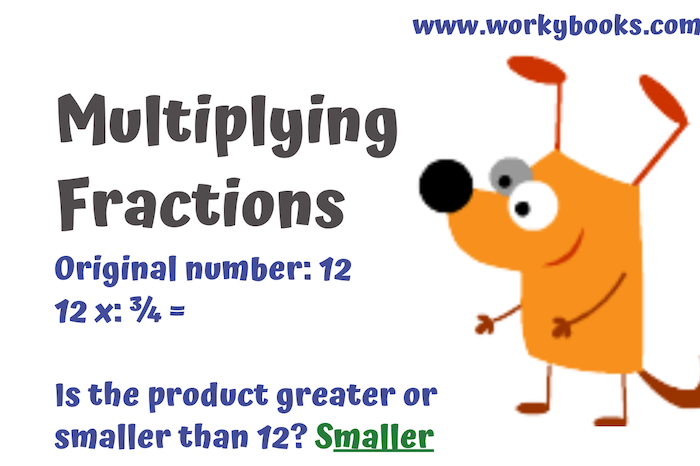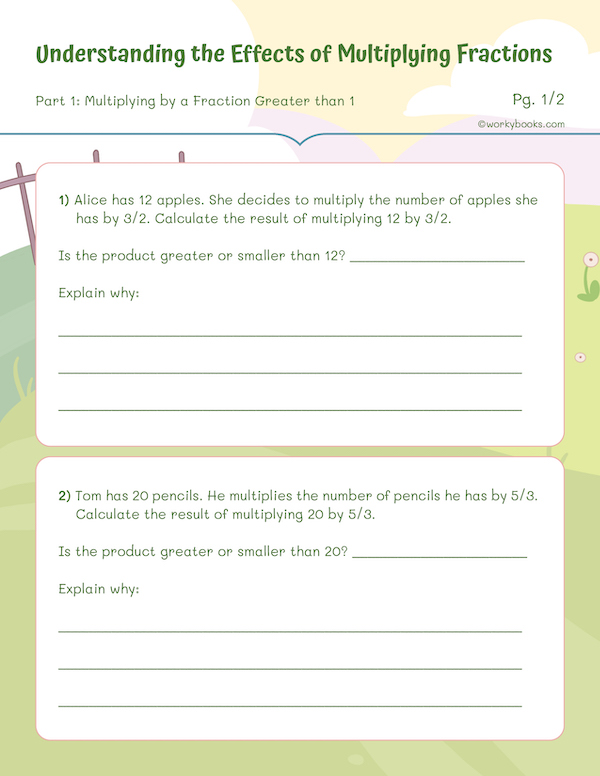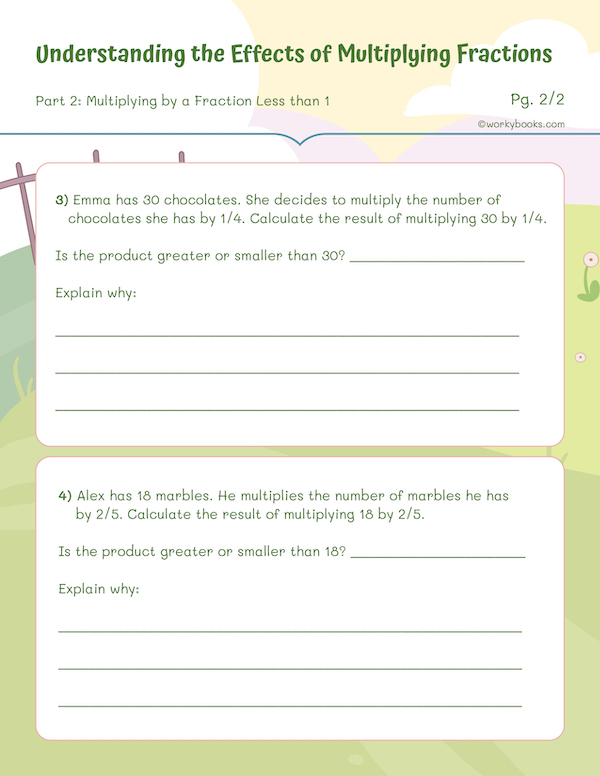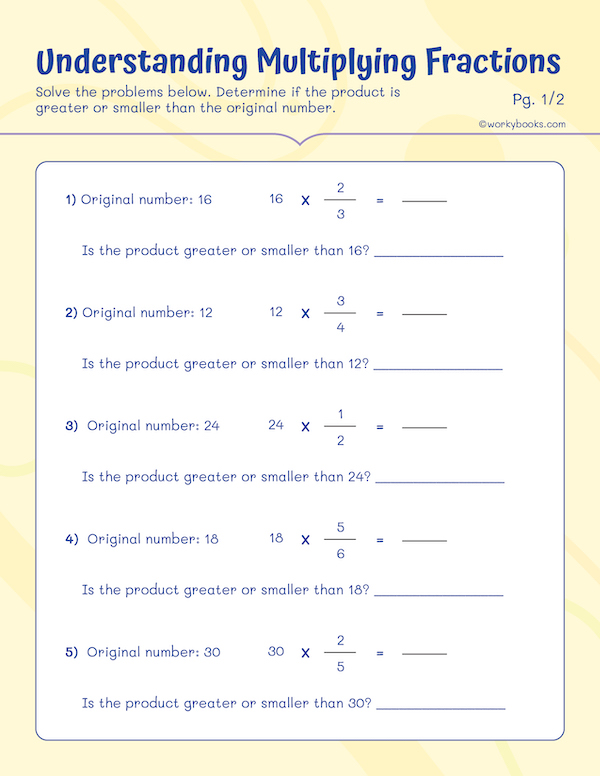Multiplying Fractions: CCSS.MATH.CONTENT.5.NF.B.5.b

Multiplying fractions covered by CCSS.MATH.CONTENT.5.NF.B.5.b is a crucial stepping stone in a student’s mathematical journey. It lays the groundwork for more advanced concepts in algebra and proportional reasoning.
What Does CCSS.MATH.CONTENT.5.NF.B.5.b Mean?
This standard states: “Interpret multiplication as scaling (resizing), by explaining why multiplying a given number by a fraction greater than 1 results in a product greater than the given number (recognizing multiplication by whole numbers greater than 1 as a familiar case); explaining why multiplying a given number by a fraction less than 1 results in a product smaller than the given number; and relating the principle of fraction equivalence a/b = (n×a)/(n×b) to the effect of multiplying a/b by 1.”
That’s quite a mouthful! Let’s break it down into simpler terms.
Key Concepts for multiplying fractions
- Multiplication as Scaling: This standard introduces the idea that multiplication can be thought of as resizing or scaling a number.
- Effect of Multiplying by Fractions:
- Multiplying by a fraction > 1 makes the result larger
- Multiplying by a fraction < 1 makes the result smaller
- Multiplying by 1 keeps the number the same
- Fraction Equivalence: Understanding how multiplying both the numerator and denominator by the same number doesn’t change the fraction’s value.
Teaching Strategies for multiplying fractions
- Visual Representations: Use number lines or area models to illustrate scaling.
- Real-Life Examples: Incorporate scenarios like resizing photos or adjusting recipes.
- Interactive Activities: Use manipulatives or digital tools to demonstrate scaling.
- Compare and Contrast: Have students compare results when multiplying by fractions greater than, less than, and equal to 1.
Real-World Applications for multiplying fractions
Understanding this concept helps students in various real-life scenarios:
- Adjusting recipe quantities
- Scaling models or drawings
- Understanding percentage increases and decreases
I. Multiplying by a Fraction Greater Than 1
When we multiply a number by a fraction greater than 1, the result is larger than the original number.
Example: Let’s multiply 4 by 3/2 (which is greater than 1)
4 × 3/2 = 12/2 = 6
Here, 6 is greater than our original number 4. We can think of this as scaling up or enlarging 4 by a factor of 3/2.

II. Multiplying by a Fraction Less Than 1
When we multiply a number by a fraction less than 1, the result is smaller than the original number.
Example: Let’s multiply 4 by 1/2 (which is less than 1)
4 × 1/2 = 4/2 = 2
Here, 2 is less than our original number 4. We can think of this as scaling down or shrinking 4 by a factor of 1/2.

Click here for more 5th grade math worksheets!
III. Relating to Fraction Equivalence
This part of the standard relates to understanding why multiplying both the numerator and denominator of a fraction by the same number doesn’t change its value.
Example: Let’s take the fraction 2/3 and multiply both top and bottom by 2
(2 × 2) / (3 × 2) = 4/6
This is equivalent to 2/3, which we can prove by simplifying 4/6:
4 ÷ 2 = 2 6 ÷ 2 = 3 So, 4/6 = 2/3
Real-World Application: Recipe Scaling
Let’s apply this to a real-world scenario of scaling a recipe.
Original recipe: 2 cups of flour
- Scaling up: If we want to make 1.5 times the recipe 2 × 3/2 = 3 cups of flour The amount increased because we multiplied by a fraction greater than 1.
- Scaling down: If we want to make half the recipe 2 × 1/2 = 1 cup of flour The amount decreased because we multiplied by a fraction less than 1.
- No change: If we multiply by 2/2 (equivalent to 1) 2 × 2/2 = 2 cups of flour The amount stayed the same because we multiplied by a fraction equal to 1.
These examples demonstrate how multiplication by fractions can be understood as scaling, and how this concept applies in practical situations. By grasping these principles, students build a strong foundation for more advanced mathematical concepts.
Worksheet 1: Applying Multiplying Fractions Worksheet

This math worksheet provides practice understanding the effects of multiplying whole numbers by fractions less than or greater than one. It includes 10 problems where students multiply a given whole number by a fraction. They must perform the calculation, then determine if the product is greater than or less than the original number. This develops conceptual understanding of how multiplying by proper, improper, and unit fractions impacts the size of a quantity.This worksheet is aligned to Common Core standards on multiplying fractions, including relating fraction equivalence to multiplying by 1.
Q.How does multiplying a fraction by a number greater than 1 affect the size of the fraction?
Answer: The product will be greater than the original fraction because multiplying by a number greater than 1 increases the size.
Q.What happens when you multiply a fraction by a number less than 1?
Answer: The product will be smaller than the original fraction because multiplying by a number less than 1 decreases the size.
Q.Explain why multiplying a fraction by 1 results in the same fraction.
Answer: Multiplying by 1 does not change the size of the fraction, as the identity property of multiplication states that any number multiplied by 1 remains unchanged.





One Comment